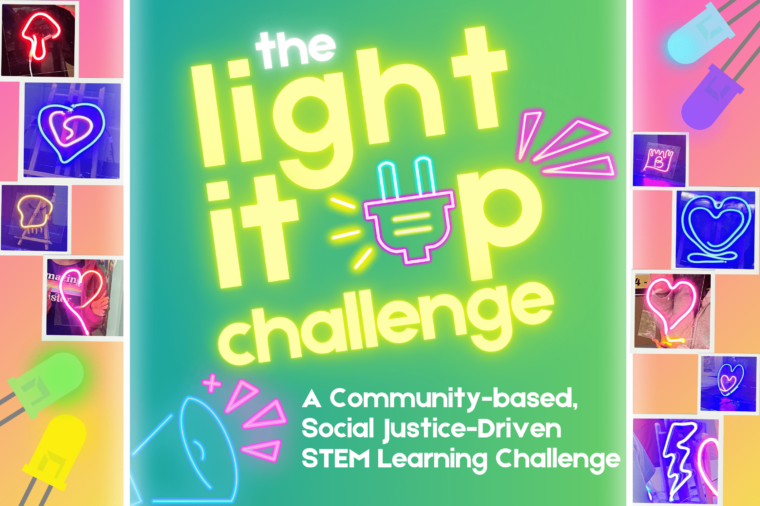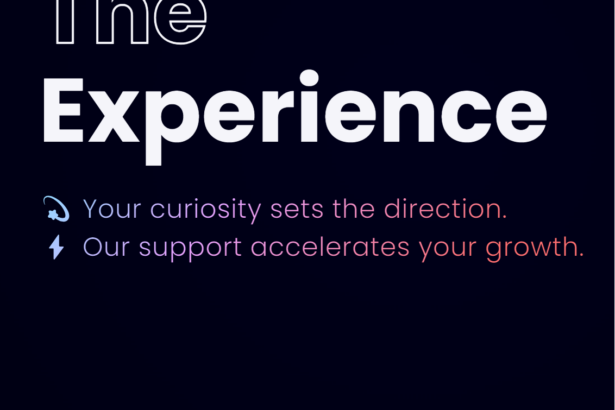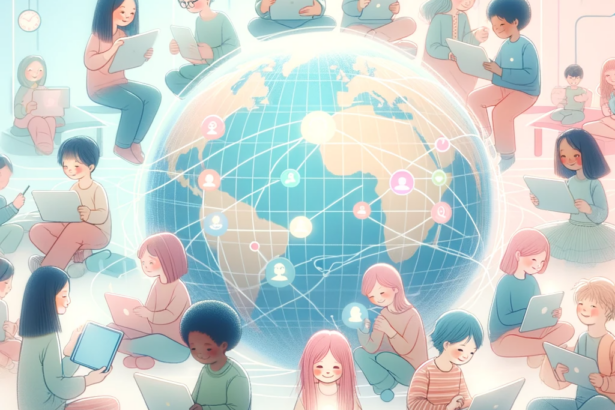How it Started
My project is a complete re-iteration of a previous middle school, out-of-school time STEM curriculum that I had designed as a former Afterschool program manager.
Oftentimes, I think our community of educators face expectations of creating meaningful learning experiences with very little room to ideate, iterate, and develop *before* delivering them to learners.
My goal in making one of my previous curriculums the focus of my project was to give myself the opportunity to truly engage in an iterative experience that centered the process without the pressures of immediate delivery, and to truly reflect on my own role and positionality as a community-based educator and learning designer. In PCE, I was asked to dream, get messy, bravely share my wonderings, start from scratch, and embrace uncertainty. Ultimately, my PCE experience truly affirmed the importance of the iterative process in the context of my work, and has left me wanting to put forth a completely redefined (and perhaps unapologetic?) approach to learning design in my future community-based youth work endeavors!

Project Focus: Addressing the STEM Learning & Interest Gap
Perhaps one of my biggest passions that brought me to HGSE in the first place was my passion for cultivating out-of-school time learning experiences that are intentionally youth-centered and actively promote community-based engagement. Specifically, I am very interested in designing community-based STEM learning experiences for middle schoolers. Indeed, this field continues to expand, yet the disparities in STEM engagement among low-income, youth of color persists. In the year 2022, I was trying to design a new STEM Enrichment group for my middle schoolers, and came across a co-curricular framework called ‘Social Justice-driven STEM:’ It was an approach utilized in a college access program to promote the nurturing of STEM connections to community-based justice work among high schoolers. In doing more research, I learned that this framework is not often implemented with younger learners, and this is where my ‘What if?’ journey of possibility began. The first iteration of this idea taught youth how to create their own mini-LED light sign through the Engineering Design Process, and PCE has allowed me to take this a step further!
In this course, my project’s trajectory evolved to showcase the ways that I learned to actively center and meaningfully contextualize practices of participatory design and design justice. Additionally, I was able to explore my own approach to Social Justice-driven STEM and evolve my first iteration of this project, honor my relationships with the youth who inspired this idea, and continue embodying practices of ‘power to, power for, power with, and power within’ as a youth educator.
My Stuck Point: Method of Delivery
In the early stages of my PCE project development, I was very much committed to ‘building onto’ the existing curriculum I had developed at my previous role. I even went on to develop a curricular/lesson outline framework as I prepared to dive into the content, but I quickly realized that this approach left me feeling stuck with how I wanted to launch my vision of this project. During Week 6, the reading from Mitch Resnick & Eric Rosenbaum’s chapter on Designing for Tinkerability really helped me shift my focus to my role in nurturing youth’s learning and the ways in which the format of this learning experience could also encourage this nurturing. This particular piece also had me recall that some of the most memorable and powerful learning moments I witnessed (and engaged in alongside) my youth having were those that encouraged messiness, and nurtured their sense of discovery – and I rarely started with a formalized lesson outline when iterating these experiences.
Thus, I decided to start with how I wanted youth to interact with the STEM content in the context of their community and through a social justice lens.
Moving Beyond Curriculum: Tinkering with Innovation Challenges and Community-Based, Situated Learning
In working with middle schoolers, I wanted to create something that promoted engagement through personal milestones, localized learning, team-based activities, and friendly competition. This is when I began to tinker with the idea of learning/innovation challenges – those that have you ‘submit’ project entries as part of a competition.
As I was brainstorming a design format for this, I remembered a STEM Challenge carried out by the local library that was in partnership with my previous youth development organization. The Cardboard Carnival Challenge invited middle schoolers to create their own motorized arcade game out of cardboard and a circuit playground. Students who participated in this challenge received a circuit playground supply kit and had the opportunity to attend optional support sessions at the local library and in different out-of-school time program partners. In having facilitated this STEM Challenge myself during its early years, I noticed the need to equip students with the basics as part of the tinkering experience, and ended up creating an internal curriculum structure to support my students in participating in the challenge. Aside from this, I found the library drop-in session formats to be inspiring for me – how can I expose my young learners to, and leverage the existing local assets in their communities? Furthermore, how can my project further and promote community connections between students and their local resources?
I landed on creating an 8-week, community-based learning challenge that provides middle schoolers with the opportunity to explore circuitry and LED Lighting through a Light Justice lens. My vision involves youth diving into a series of weekly learning milestone ‘modules’ and community engagement in ways that empowers them to learn and innovate possibilities for light justice in their own communities, while equipping them with the skills to create their own LED Light sign. While I am still working out the exact target milestones of each weekly focus, I am looking forward to providing youth with a cohesive learning experience that promotes tinkering and supportive, localized learning.

Light Justice through a Case-based Approach: Open-ending Problem-Solving & Reflections
As I developed my project, another significant point of iteration was in thinking about how to incorporate reflection as part of the learning challenge. I soon realized I did not have many references when it came to this – especially with STEM learning. Fortunately, I ended up getting inspiration from the The ID CaseBook: Case Studies in Instructional Design introductory chapter by Peggy Ertmer and colleagues, specifically from the way in which the text framed case-learning approaches as immersive opportunities to develop reflective mindsets through storytelling (Ertmer et al., 2024). Specifically, I started to think about the ways in which students could discover the impacts of LED Lighting and Light justice through “case studies” on lighting installations in community spaces (i.e., school gymnasiums, parks, etc.). In fact, in my research, I found a website that documents specific LED installation projects in a ‘before and after’ format to showcase the impact of LED Lighting. This inspired me to incorporate this approach as part of the learning experience, as I think it could provide students with very meaningful, open-ended opportunities to reflect on the impacts of Light Justice and encourage the very iterative mindsets that are fundamental to STEM practices. I also think this learning approach can be utilized to hold space for reflections as part of students’ learning journey about light justice, a topic that is inherently tied to dialogues around oppression and justice work. In my week 6 journal, I wrote about how integrating case-based learning in this way can “promote safe, loving spaces for learning…[and] be seen as a very distinct act of resistance and disruption while engaging with STEM as a field itself.” At the end of the day, I want youth who engage with my project to feel nurtured and supported as they bravely explore one of many STEM topics that, historically, has never been made accessible to them in the first place.
Next Steps: Continue Developing Learning Milestones & Piloting at the Harvard Ed Portal
As I finish out my PCE experience, I am very excited to have the opportunity to pilot my project at the Harvard Ed Portal! As a Pedagogy and Instruction Intern, I look forward to offering this learning experience to youth in the Allston-Brighton community, and also provide Harvard undergraduate students with a deeper dive into the iterative process of developing intentional STEM learning experiences. In doing so, I also plan on further developing the weekly learning milestones overview, and developing a series of ‘branded’ learning materials as part of this learning challenge.
Lastly, one of my biggest visions for this project is to develop a digital platform that houses this learning challenge so that it can be accessible to as many students as possible, and applicable to various community contexts. This project is part of a larger dream of mine to launch an educational venture that develops immersive, community-based learning challenges for youth of color in underserved communities, and I am extremely grateful to have had the opportunity and support from this course to finally move beyond my own wonderings and dive deep into iterating!
A Thank You to my Y.O.U. | Chute Community <3
This project was made with so much love and gratitude for my Y.O.U. | Chute Middle Schoolers. They have completely redefined my approach as a community-based educator, and have shown me just how wonderful it is to be a learner alongside them – always wondering, always exploring possibility. Thank you for trusting me with every new idea I put forth – the most exciting part was getting to experience every uncertainty, mess, and ‘Aha!’ moment in community with you all! I’m so excited to bring this project back to y’all, where it all started!




